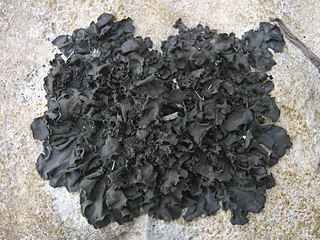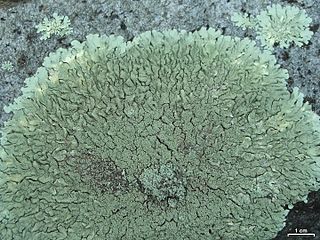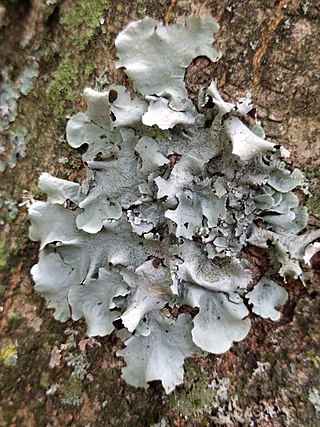
Collema is a genus of lichens in the family Collemataceae. The photobiont is the cyanobacterium genus Nostoc. Species in this genus typically grow on nutrient-rich bark or somewhat siliceous or calcareous rocks in humid environments.

Parmotrema is a genus of lichen belonging to the family Parmeliaceae. It is a large genus, containing an estimated 300 species, with a centre of diversity in subtropical regions of South America and the Pacific Islands.

Xanthoparmelia is a genus of foliose lichens in the family Parmeliaceae. This genus of lichen is commonly found in the United States, as well as Australia, New Zealand and Ecuador.

Parmotrema perlatum, commonly known as the powdered ruffle lichen, is a common species of foliose lichen in the family Parmeliaceae. The species has a cosmopolitan distribution and occurs throughout the Northern and Southern Hemispheres. Parmotrema perlatum is a prominent and widely recognised species within its genus across primarily temperate zones, preferring humid, oceanic-suboceanic habitats. It is found in diverse geographic areas including Africa, North and South America, Asia, Australasia, Europe, and islands in the Atlantic and Pacific oceans. It is usually grows on bark, but occasionally occurs on siliceous rocks, often among mosses.

Parmotrema austrosinense is a widely distributed species of lichen in the family Parmeliaceae. It was first officially described as a species of Parmelia by Austrian botanist Alexander Zahlbruckner in 1930. Mason Hale transferred it to Parmotrema in 1974.
Parmotrema abessinicum is a species of corticolous lichen in the family Parmeliaceae. It has been recorded from Africa, Asia, and Oceania.
Parmotrema abnuens is a species of corticolous lichen in the family Parmeliaceae. It was first introduced to science in 1885 as a species of Parmelia by William Nylander in 1885, who described the lichen from samples collected in Uruguay. Mason Hale transferred it to the genus Parmotrema in 1974. The species has also been recorded from Brazil and India.
Parmotrema aldabrense is a species of lichen in the family Parmeliaceae that is found in Africa. It was first described by Carroll William Dodge in 1959 as a species of Parmelia. Mason Hale transferred it to the genus Parmotrema in 1974. The type collection was made in the Aldabra Islands, where it was found growing on tamarind. It has also been recorded from Madagascar. The lichen has an olive-buff coloured thallus measuring up to 14 cm (5.5 in) in diameter.
Parmotrema amboimense is a species of lichen in the family Parmeliaceae that is found in Africa. It was first described by Carroll William Dodge in 1959 as a species of Parmelia. Mason Hale transferred it to the genus Parmotrema in 1974. The type collection was made in Cuanza Sul Province (Angola), where it was found growing at an elevation of 1,000 m (3,300 ft); Dodge also noted the presence of the lichen in Cameroon and Uganda. Parmotrema amboimense has a pale olive-buff coloured thallus measuring up to 10 cm (4 in) in diameter.

Parmotrema mellissii is a widely distributed species of corticolous lichen in the family Parmeliaceae. It was first described by Carroll William Dodge in 1959 as a species of Parmelia. Mason Hale transferred it to the genus Parmotrema in 1974. The type collection was made in Saint Helena. Parmotrema mellissii has a pale yellowish-buff coloured thallus at least 12 cm (5 in) in diameter, comprising rounded lobes about 15 mm wide and long. It has been found in the southern U.S.A., the Neotropics from Mexico to Colombia and Brazil, Africa, Asia, Australia and Oceania.
Parmotrema araucariarum is a species of lichen in the family Parmeliaceae. It was first described scientifically as a species of Parmelia by Austrian botanist Alexander Zahlbruckner in 1909. Mason Hale transferred it to the genus Parmotrema in 1974. The lichen has been reported from Kenya, Tanzania, and South America.

Parmotrema zollingeri is a species of lichen in the family Parmeliaceae. It was originally described in 1860 as a species of Parmelia by German lichenologist Johann Adam Philipp Hepp, and named after Swiss botanist Heinrich Zollinger. Mason Hale transferred it to the genus Parmotrema in 1974.
Parmotrema andinum is a species of lichen in the family Parmeliaceae. It was first described as new to science in 1879 by Johannes Müller Argoviensis as a species of Parmelia. Mason Hale transferred it to Parmotrema in 1975. It is found in Africa, Asia, and South America. In Mauritania, this species is used as tobacco. A metabolomic analysis of this lichen revealed the presence of 30 secondary compounds.
Parmotrema appendiculatum is a species of lichen in the family Parmeliaceae. Found in South America, it was originally described by French botanist Antoine Laurent Apollinaire Fée in 1837 as a species of Parmelia. Mason Hale transferred it to the genus Parmotrema in 1974.

Parmotrema rampoddense, commonly known as the long-whiskered ruffle lichen, is a species of foliose lichen in the family Parmeliaceae. It is widely distributed in tropical regions and grows on the bark of oak and palm trees.

Parmotrema arnoldii, commonly known as the powdered ruffle lichen, is a widely distributed species of lichen in the family Parmeliaceae. It has been recorded from Africa, Asia, Europe, Oceania, Macaronesia, and North and South America.
Bulbothrix meizospora is a species of foliose lichen in the family Parmeliaceae. It is found in Africa, Asia, and South America, where it grows on tree bark.

Parmotrema hypoleucinum is a species of foliose lichen in the family Parmeliaceae. A study of Parmotrema hypoleucinum in Tunisia revealed that it contains atranorin and (+)-iso-usnic acid, chemical compounds of interest for their anti-inflammatory activity. The species was originally scientifically described by Austrian lichenologist Julius Steiner in 1918 as a member of genus Parmelia. Mason Hale transferred it to Parmotrema in 1974.

Arctoparmelia incurva is a species of saxicolous (rock-dwelling), foliose lichen in the family Parmeliaceae. First described in 1794 by Christiaan Hendrik Persoon, it has undergone several taxonomic reclassifications before being placed in its current genus in 1986. This yellowish-green lichen, characterised by its narrow, convex lobes and globular soralia, typically grows on sun-exposed siliceous rocks in alpine and arctic habitats. It has a circumpolar distribution, found across North America, Europe, and parts of Asia. A. incurva can be distinguished from similar species by its specific morphological features and chemical spot test reactions. The lichen is known to host several parasitic fungi and has shown tolerance to acid pollution.











